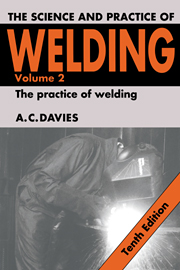Book contents
- Frontmatter
- Contents
- Preface
- 1 Manual metal arc welding
- 2 Gas shielded metal arc welding
- 3 Tungsten electrode, inert gas shielded welding processes (TIG), and the plasma arc process
- 4 Resistance welding and flash butt welding
- 5 Additional processes of welding
- 6 Oxy-acetylene welding
- 7 Cutting processes
- 8 The welding of plastics
- Appendixes
- 1 Welding symbols: British, American
- 2 Simplified notes on the operation of a thyristor
- 3 Proprietary gases and mixtures
- 4 Tests for wear-resistant surfaces
- 5 Conversion factors
- 6 Low hydrogen electrode, downhill pipe welding
- 7 The manufacture of extruded MMA electrodes
- 8 Notes on fire extinguishing
- 9 Table of brazing alloys and fluxes
- 10 Latest plant and equipment
- 11 Refraction and reflection
- 12 Notes on the welding of Duplex and Super Duplex stainless steels
- 13 Welding fumes: health and safety
- 14 Lasers and laser welding
- City and Guilds of London Institute examination questions
- Index
12 - Notes on the welding of Duplex and Super Duplex stainless steels
Published online by Cambridge University Press: 11 May 2010
- Frontmatter
- Contents
- Preface
- 1 Manual metal arc welding
- 2 Gas shielded metal arc welding
- 3 Tungsten electrode, inert gas shielded welding processes (TIG), and the plasma arc process
- 4 Resistance welding and flash butt welding
- 5 Additional processes of welding
- 6 Oxy-acetylene welding
- 7 Cutting processes
- 8 The welding of plastics
- Appendixes
- 1 Welding symbols: British, American
- 2 Simplified notes on the operation of a thyristor
- 3 Proprietary gases and mixtures
- 4 Tests for wear-resistant surfaces
- 5 Conversion factors
- 6 Low hydrogen electrode, downhill pipe welding
- 7 The manufacture of extruded MMA electrodes
- 8 Notes on fire extinguishing
- 9 Table of brazing alloys and fluxes
- 10 Latest plant and equipment
- 11 Refraction and reflection
- 12 Notes on the welding of Duplex and Super Duplex stainless steels
- 13 Welding fumes: health and safety
- 14 Lasers and laser welding
- City and Guilds of London Institute examination questions
- Index
Summary
Duplex and Super Duplex stainless steels are particularly useful in the petrochemical industry because of their pitting and corrosion resistance. Duplex stainless steels are so called because they have two phases in their microstructure, ferrite and austenite, so they are ferritic-austenitic steels. One of the most common of the Duplex steels has 22% Cr, 5% Ni, 3% Mo and 1% N2, remainder ferrite. The ferrite gives the high tensile strength and the austenite gives the toughness. The latest of these steels is called Super Duplex stainless steel and has a greater resistance to corrosion and a high pitting resistance. A typical example of a Super Duplex steel has 25% Cr, 7% Ni, 4% Mo and 0.15% N2, remainder ferrite. Duplex steels are not sensitive to corrosion cracking but must not be worked above 300°C, as above this embrittlement occurs. The ferritic-austenitic balance is important as a high ferrite content will cause brittleness and a low one will cause a lowering of resistance to stress corrosion. Contents of 30–70 FN (ferrite number) are normal. The balance between ferrite and austenite depends upon the heat treatment and the composition of the filler metal, the heat input when welding and the interpass temperature.
- Type
- Chapter
- Information
- The Science and Practice of Welding , pp. 445 - 448Publisher: Cambridge University PressPrint publication year: 1993



